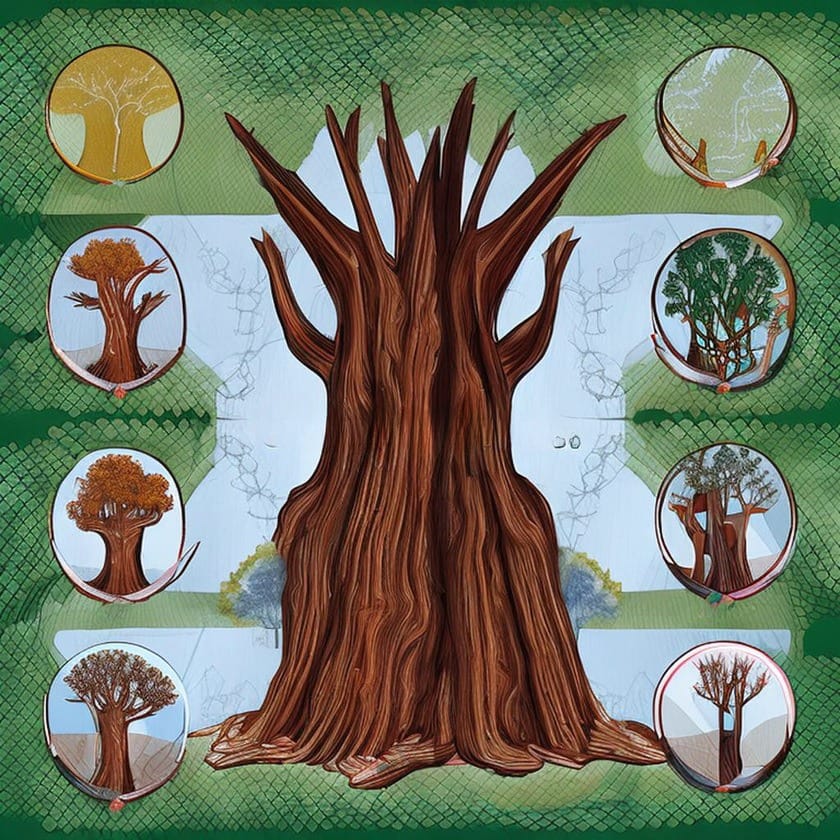Sacred trees in South America
Sacred trees have played an important role in the cultures and religions of many Indigenous communities in South America for centuries. These trees are often associated with spiritual significance and are the focus of many rituals and ceremonies.
In many Indigenous cultures, sacred trees are believed to be the homes of spirits or deities. People may offer food, drink, or other offerings to these spirits as a way of seeking their blessings or protection. Trees are also used as places of worship, and people may gather under the shade of a sacred tree to pray, sing, or perform other religious ceremonies.
In some Indigenous cultures, certain trees are believed to have healing properties. The bark, leaves, or fruit of these trees may be used to treat a wide range of ailments, from respiratory issues to digestive problems. Some of these trees have even been used to create traditional medicines that are still used today.
Sacred trees have also played an important role in the art and literature of many Indigenous communities in South America. They are often depicted in paintings, sculptures, and other forms of art, and their beauty and symbolism have inspired many artists over the years.
Unfortunately, many of South America’s sacred trees are at risk due to deforestation, climate change, and other environmental threats. This has led to efforts to protect and preserve these trees, both for their cultural significance and for their ecological value.
Efforts to protect sacred trees in South America include the establishment of protected areas, the promotion of sustainable forestry practices, and the education of local communities about the importance of preserving their cultural heritage. By working together to protect these trees, we can ensure that they continue to play an important role in the cultural heritage and spiritual practices of Indigenous communities in South America for generations to come.
Sacred trees in South America and their symbolic significance
The Ceibo Tree
The Ceibo Tree, a majestic member of the Erythrina genus, holds a revered place in the hearts of many indigenous cultures across South America, particularly within the Amazon Basin. Celebrated for its vibrant, scarlet blossoms and robust presence, the Ceibo tree is deeply intertwined with cultural and spiritual beliefs. Indigenous peoples regard it as a symbol of strength, stability, and protection. This sacred tree often features prominently in traditional medicine and rituals, where it is believed to possess powerful healing properties. Various parts of the Ceibo tree are utilized in herbal remedies to treat ailments ranging from inflammation to respiratory issues. Additionally, its bark, leaves, and flowers are integral to numerous ceremonial practices aimed at invoking spiritual protection and community well-being. The profound respect for the Ceibo tree is also reflected in folklore and storytelling, where it often symbolizes resilience and the enduring connection between humans and nature. However, like many species within the Amazon Basin, the Ceibo tree faces threats from deforestation and habitat destruction, driven by agricultural expansion and logging activities. Conservation efforts are vital to preserve this culturally and ecologically significant tree. Promoting sustainable land-use practices and recognizing the traditional knowledge of indigenous communities can help protect the Ceibo tree. Ensuring its survival is essential not only for maintaining biodiversity but also for preserving the rich cultural heritage and ecological wisdom of the Amazon’s indigenous peoples.
The Palma Christi Tree
The Palma Christi Tree, known scientifically as the castor oil plant, holds a sacred status among many indigenous cultures in South America. Revered for its association with healing and protection, this remarkable tree plays a central role in the spiritual and medicinal practices of these communities. The seeds of the Palma Christi Tree are the source of castor oil, a potent substance widely used in traditional medicine. Castor oil is renowned for its therapeutic properties, including its ability to treat ailments such as digestive issues, skin conditions, and inflammation. Beyond its medicinal applications, the Palma Christi Tree is deeply embedded in ritualistic practices. Its oil and other parts are often utilized in ceremonies intended to invoke protection and purification, reflecting the tree’s revered status as a guardian and healer. The cultural significance of the Palma Christi Tree is further highlighted in indigenous folklore, where it is frequently depicted as a symbol of resilience and divine intervention. Despite its importance, the Palma Christi Tree, like many other plants integral to indigenous traditions, faces threats from habitat loss and environmental changes. Efforts to conserve this sacred tree are crucial, encompassing sustainable harvesting practices and the preservation of traditional knowledge. Supporting these initiatives not only helps protect the Palma Christi Tree but also ensures the continuation of the rich cultural and spiritual heritage of South America’s indigenous peoples. By safeguarding this tree, we honor the deep connection between nature and culture and promote the resilience of both ecosystems and traditional communities.
The Coca Tree
The Coca Tree, an essential and revered plant among many indigenous cultures in the Andes region of South America, is considered sacred and holds deep cultural significance. Associated with life, fertility, and energy, the coca tree is integral to the spiritual and daily lives of the Andean people. The leaves of the coca tree are believed to possess powerful spiritual properties and are used extensively in traditional medicine and rituals. For centuries, coca leaves have been chewed or brewed into teas to alleviate hunger, fatigue, and altitude sickness, offering a natural source of energy and well-being. Beyond their medicinal uses, coca leaves play a vital role in various ceremonial practices. They are often used in offerings to Pachamama, the earth goddess, and in rituals aimed at ensuring fertility, prosperity, and protection for the community. The act of chewing coca leaves, known as “acullico,” is a sacred tradition that fosters social bonds and connects individuals to their ancestral heritage. Despite its profound cultural importance, the coca tree is frequently misunderstood and stigmatized due to its association with the production of illicit drugs. This negative perception poses challenges to the preservation of traditional practices and the livelihoods of indigenous communities. Efforts to protect and honor the coca tree should include recognizing and respecting its cultural significance, promoting sustainable cultivation, and supporting the rights of indigenous peoples to maintain their traditions. By doing so, we can ensure that the sacred legacy of the coca tree endures, preserving its role as a symbol of life, vitality, and cultural identity in the Andes.
The Jatobá Tree
The Jatobá Tree, a distinguished member of the Hymenaea genus, holds a revered place among many indigenous cultures throughout South America. Esteemed for its associations with fertility, prosperity, and protection, the Jatobá tree is often considered sacred and is deeply intertwined with the cultural and spiritual practices of these communities. This majestic tree, known for its resilience and longevity, is frequently planted near homes, where it is believed to bring good luck and abundance to those who reside nearby. Its robust presence serves as a symbol of stability and well-being, embodying the hopes and aspirations of the people.
In addition to its symbolic significance, the Jatobá tree offers numerous practical benefits. Its hardwood is highly valued for its durability and strength, making it a preferred material for construction and crafting. The tree’s bark, leaves, and fruits are also utilized in traditional medicine. Indigenous healers prepare various remedies from the Jatobá tree to treat respiratory issues, digestive disorders, and other ailments, reflecting its role as a natural pharmacy.
The cultural practices surrounding the Jatobá tree include rituals and ceremonies intended to honor the tree’s protective and life-giving qualities. These practices not only reinforce community bonds but also maintain a deep connection to the natural world. However, like many other culturally significant species, the Jatobá tree faces threats from deforestation and environmental changes. Efforts to conserve this sacred tree must include sustainable management practices and the preservation of traditional knowledge.
Recognizing the Jatobá tree’s importance can foster greater appreciation and support for the indigenous cultures that hold it dear. By protecting the Jatobá tree, we contribute to the preservation of biodiversity, cultural heritage, and the spiritual well-being of South America’s indigenous communities.
The Palo Santo Tree – The Palo Santo tree is a type of Bursera tree that is considered sacred by many indigenous cultures in South America and is associated with spiritual purification, protection, and healing. The tree is often used in traditional medicine and rituals and is believed to have powerful spiritual properties.
These are just a few examples of the many sacred trees found in South America, each with its own unique symbolism and significance. For many indigenous cultures in South America, trees are seen as living beings with their own spirits, and their presence and protection is considered essential for the well-being of the community.
Shop tip
Ceibo tree on Amazon
Palma Christi Tree on Amazon
Coca Tree on Amazon
The Jatobá Tree on Amazon
Sacred trees on Amazon

Thank you for likes, shares and comments! 🌳🌴🌲🌵
Source OpenAI’s chatGPT Language Models, Dalle, AI trot and Fleeky
images Picsart and MIB
Invest in your future
Take time to learn
Embark on your journey in affiliate marketing and website creation alongside an incredible community and myself. Invest in your future by dedicating time to learn and earn. Take all the time you need to master the basics before aiming higher. Give it a try and sign up for free. You won't regret it! Discover the possibilities for yourself...


